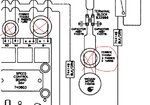ron-e-g
Junior Member level 1

Hello,
I'm by no means an electronic ..anything. I live in a rural area so finding someone who has knowledge to hire to help me has been futile. Our church has a gymnasium, and small school attached. The gym has/had a Minuteman 320 walk behind floor scrubber. The motor for the vacuum system has not worked since I came on board as a sort of maintenance man/ carpenter six years ago. All other motors/ functions work. I replaced the motor with used (supposedly working one) from ebay. It still does not work. I have the electrical schematics, but don't know the first thing about how to test a 36 volt DC system with a Radio shack true RMS 42 DVM. If I only knew how I could probably test both wires back to their source to see where the current stops? maybe? The motor has two wires both white.
Any help would be greatly appreciated.
Ron
I'm by no means an electronic ..anything. I live in a rural area so finding someone who has knowledge to hire to help me has been futile. Our church has a gymnasium, and small school attached. The gym has/had a Minuteman 320 walk behind floor scrubber. The motor for the vacuum system has not worked since I came on board as a sort of maintenance man/ carpenter six years ago. All other motors/ functions work. I replaced the motor with used (supposedly working one) from ebay. It still does not work. I have the electrical schematics, but don't know the first thing about how to test a 36 volt DC system with a Radio shack true RMS 42 DVM. If I only knew how I could probably test both wires back to their source to see where the current stops? maybe? The motor has two wires both white.
Any help would be greatly appreciated.
Ron
Attachments
Last edited:











![20180727_070850[1].jpg](/data/attachments/79/79266-917087b27c69a9574380479b94314e0a.jpg)
![20180727_072036[1].jpg](/data/attachments/79/79267-a939f332b957751fc2dc36222f614b5c.jpg)
![20180727_072046[1].jpg](/data/attachments/79/79275-ab186fc20f310e448aa67c758f381719.jpg)